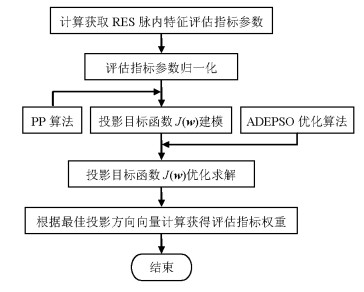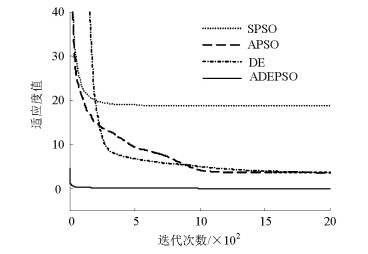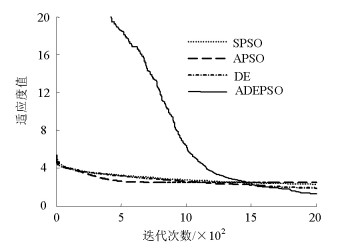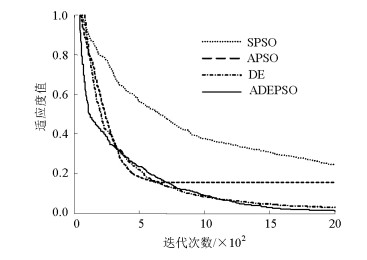Intrapulse Feature Evaluation Model of Radar Emitter Signal Based on Differential Evolution, Particle Swarm Optimization and Projection Pursuit Algorithm
-
摘要: 针对雷达辐射源信号脉内特征综合评估存在标准单一、缺乏客观性等问题,提出了基于群体智能的雷达辐射源信号脉内特征综合评估模型.首先,通过投影寻踪算法将雷达辐射源信号脉内特征的综合评估问题转化为有条件限制的多元非线性目标函数的优化问题;其次,通过改进的粒子群优化算法与差分进化算法的结合得到新的智能算法;最后,利用该算法实现多元非线性目标函数的优化求解.仿真结果表明:该群体智能算法对Rosenbrock测试函数的最优适应度值最小,对Rastrigrin函数和Girewank测试函数的最优适应度值为0,说明该算法的计算精度优于其他算法.同时适应度值的方差比标准粒子群算法和差分进化算法小,说明该算法的收敛性和鲁棒性较好.通过与加速遗传算法对评估问题目标函数5次优化结果的比较,本算法的计算结果没有波动,说明基于群体智能的RES脉内特征综合评估模型能够更客观、更有效地实现对RES脉内特征的综合评估.Abstract: To address the problems in comprehensive evaluation of radar emitter signal (RES) intrapulse features, such as incomplete evaluation criteria and the lack of objectivity, a new comprehensive evaluation model of RES intrapulse features was proposed based on swarm intelligence. First, the comprehensive evaluation problem of RES intrapulse features was converted into an optimization problem of the conditional multivariate nonlinear objective function through the projection pursuit algorithm. Secondly, the new swarm intelligence algorithm was obtained through the combination of the improved particle swarm optimization algorithm and the differential evolution algorithm. Thirdly, the optimization and solution of the multivariate nonlinear objective function was achieved using the proposed algorithm. The simulation results show that the optimal fitness of the Rosenbrock test function of this new intelligence algorithm is minimal, and the optimal fitness values of the Rastrigrin test function and the Girewank test function are zero, indicating that the calculation accuracy of the proposed algorithm is better than the standard particle swarm optimization algorithm and the differential evolution algorithm. At the same time, the variance of the fitness value of the proposed algorithm is smaller than those of the standard particle swarm optimization algorithm and the differential evolution algorithm, which indicates that the convergence and robustness of the proposed algorithm are better. According to the objective function of the evaluation problem, the results of the proposed algorithm do not fluctuate when comparing the five optimization results with those of the accelerated genetic algorithm, which shows that the intrapulse feature evaluation model based on swarm intelligence can effectively achieve the objective of comprehensive evaluation of RES intrapulse features.
-
表 1 基于标准测试函数的不同算法的测试结果
Table 1. Test results of different algorithms based on standard test functions
测试函数 Fitness SPSO APSO DE ADEPSO Rosenbrock best 8.394 6.802×10-1 5.196×10-5 3.415×10-5 worst 4.512×101 7.668 3.987 5.900×10-1 mean 2.139×101 3.560 5.315×10-1 5.348×10-2 Std. 1.018×101 1.939 1.378 1.136×10-1 Rastrigrin best 2.904 3.980 7.105×10-15 0.000 worst 2.599×101 3.084×101 9.975 7.099 mean 1.175×101 9.916 4.732 6.273×10-1 Std. 6.626 5.655 2.268 1.493 Girewank best 2.219×10-3 1.110×10-16 2.373×10-4 0.000 worst 4.432×10-2 1.160×10-8 5.662×10-2 2.517×10-2 mean 1.836×10-2 4.291×10-10 2.094×10-2 2.891×10-3 Std. 1.045×10-2 2.122×10-9 1.418×10-2 6.401×10-3 表 2 归一化处理后的投影数据
Table 2. The normalized projection data
特征 C1 C2 C3 C4 C5 C6 IF 0 0 0 1.000 0 0.927 RC 1.000 1.000 1.000 0 1.000 1.000 WGM 0.539 0.921 0.732 0.174 1.000 0 表 3 不同算法的权重优化结果
Table 3. The weight optimization results of different algorithms
次数 权重计算结果 RAGA 本文算法 1 (0.211, 0.248, 0.232, 0.009, 0.261, 0.039) (0.226, 0.240, 0.240, 0.027, 0.240, 0.027) 2 (0.228, 0.265, 0.233, 0.003, 0.249, 0.023) (0.226, 0.240, 0.240, 0.027, 0.240, 0.027) 3 (0.215, 0.242, 0.233, 0.006, 0.239, 0.065) (0.226, 0.240, 0.240, 0.027, 0.240, 0.027) 4 (0.234, 0.248, 0.199, 0.002, 0.250, 0.068) (0.226, 0.240, 0.240, 0.027, 0.240, 0.027) 5 (0.236, 0.238, 0.243, 0.013, 0.245, 0.026) (0.226, 0.240, 0.240, 0.027, 0.240, 0.027) -
GUO Qiang, QU Zhenshen, WANG Changhong. Pulse-to-pulse periodic signal sorting features and feature extraction in radar emitter pulse sequences[J]. Journal of Systems Engineering and Electronics, 2010, 21(3):382-389. doi: 10.3969/j.issn.1004-4132.2010.03.006 GUO Qiang, NAN Pulong, ZHANG Xiaoyu, et al. Recognition of radar emitter signals based on SVD and AF main ridge slice[J]. Journal of Communications and Networks, 2015, 17(5):491-498. doi: 10.1109/JCN.2015.000087 白航, 赵拥军, 胡德秀.时频图像局部二值模式特征在雷达信号分类识别中的应用[J].宇航学报, 2013, 34(1):139-146. doi: 10.3873/j.issn.1000-1328.2013.01.020BAI Hang, ZHAO Yongjun, HU Dexiu. Radar signal recognition based on the local binary pattern feature of time-frequency image[J]. Journal of Astronautics, 2013, 34(1):139-146. doi: 10.3873/j.issn.1000-1328.2013.01.020 ZHU Bin, JIN Weidong, YU Zhibin. Texture feature extraction of advanced radar emitter signals[J]. ICIC Express Letters, 2014, 8(9):2383-2387. 王世强, 张登福, 毕笃彦.双谱二次特征在雷达信号识别中的应用[J].西安电子科技大学学报, 2012, 39(2):127-132. doi: 10.3969/j.issn.1001-2400.2012.02.021WANG Shiqiang, ZHANG Dengfu, BI Duyan. Research on recognizing the radar signal using the bispectrum cascade feature[J]. Journal of Xidian University, 2012, 39(2):127-132. doi: 10.3969/j.issn.1001-2400.2012.02.021 邓延丽, 金炜东, 李家会, 等.基于聚集离散性与可分性的雷达信号特征评价[J].计算机应用, 2013, 33(7):1946-1949. http://d.old.wanfangdata.com.cn/Periodical/jsjyy201307038 DENG Yanli, JIN Weidong, LI Jiahui, et al. Feature evaluation of radar signal based on aggregation, discreteness and divisibility[J]. Journal of Computer Applications, 2013, 33(7):1946-1949. doi: 10.3724/SP.J.1087.2013.01946 邓延丽, 金炜东, 余志斌.基于类别距离和Bhattacharyya距离的雷达信号特征评价[J].计算机应用研究, 2012, 29(11):4079-4081. doi: 10.3969/j.issn.1001-3695.2012.11.019DENG Yanli, JIN Weidong, YU Zhibin. Feature evaluation of radar signal based on category distance and Bhattacharyya distance[J]. Application Research of Computers, 2012, 29(11):4079-4081. doi: 10.3969/j.issn.1001-3695.2012.11.019 吴思东, 朱明, 付克昌.基于多元集对分析的辐射源信号熵特征评价[J].电路与系统学报, 2013, 18(2):298-304. doi: 10.3969/j.issn.1007-0249.2013.02.050WU Sidong, ZHU Ming, FU Kechang. Entropy feature evaluation of radar emitter signals based on SPA[J]. Journal of Circuits and Systems, 2013, 18(2):298-304. doi: 10.3969/j.issn.1007-0249.2013.02.050 徐璟, 何明浩, 陈昌孝.雷达辐射源信号识别结果评估方法研究[J].电波科学学报, 2014, 29(2):300-304, 315. http://d.old.wanfangdata.com.cn/Periodical/dbkxxb201402018XU Jing, HE Minghao, CHEN Changxiao. Performance evaluation method for radar emitter signals recognition[J]. Chinese Journal of Radio Science, 2014, 29(2):300-304, 315. http://d.old.wanfangdata.com.cn/Periodical/dbkxxb201402018 徐璟, 何明浩, 陈昌孝.基于理想排序的雷达信号识别效能评估方法[J].电波科学学报, 2015, 30(3):554-559. http://d.old.wanfangdata.com.cn/Periodical/dbkxxb201503023XU Jing, HE Minghao, CHEN Changxiao. Effectiveness evaluation of signal recognition based on AHP-I2TOPSIS[J]. Chinese Journal of Radio Science, 2015, 30(3):554-559. http://d.old.wanfangdata.com.cn/Periodical/dbkxxb201503023 徐璟, 何明浩, 郁春来.雷达辐射源信号识别效能评估的I2TOPSIS方法[J].信号处理, 2015, 31(3):253-258. doi: 10.3969/j.issn.1003-0530.2015.03.001XU Jing, HE Minghao, YU Chunlai. Effectiveness evaluation of radar emitter signal recognition based on I2TOPSIS[J]. Journal of Signal Processing, 31(3):253-258. doi: 10.3969/j.issn.1003-0530.2015.03.001 YU Zhibin, CHEN Chunxia. The radar signal feature-separability model analysis[C]//Advanced Materials Research. Guangzhou: [s.n.], 2011, 268/269/270: 1484-1487. ZHU B, JIN W D, YU Z B, et al. Feature separability evaluation for advanced radar emitter signals[C]//Communications in Computer and Information Science. Shanghai: Springer-Verlag. 2012: 204-212. 朱斌, 金炜东, 余志斌.复杂体制雷达辐射源信号特征的FAHP评价[J].计算机工程与应用, 2012, 48(20):18-22. doi: 10.3778/j.issn.1002-8331.2012.20.004ZHU Bin, JIN Weidong, YU Zhibin. FAHP-based feature evaluation for advanced radar emitter signals[J]. Computer Engineering and Applications, 2012, 48(20):18-22. doi: 10.3778/j.issn.1002-8331.2012.20.004 段美军, 金炜东, 杨志新.一种雷达辐射源信号多目标特征评价模型[J].计算机应用研究, 2012, 29(8):2912-2914. doi: 10.3969/j.issn.1001-3695.2012.08.029DUAN Meijun, JIN Weidong, YANG Zhixin. Multi-objective characteristics evaluation model of radar emitter signal[J]. Application Research of Computers, 2012, 29(8):2912-2914. doi: 10.3969/j.issn.1001-3695.2012.08.029 SU Yu, SHAN Shiguang, CHEN Xilin. Classifiability-based discriminatory projection pursuit[J]. IEEE Transactions on Neural Networks, 2011, 22(12):2050-2061. doi: 10.1109/TNN.2011.2170220 ALADJEM M. Projection pursuit mixture density estimation[J]. IEEE Transactions on Signal Processing, 2005, 53(11):4376-4383. doi: 10.1109/TSP.2005.857007 ZHU B, JIN W, YU Z. The distribution characteristics analysis of advanced RES feature[C]//Communications in Computer and Information Science. Singapore: Springer-Verlag. 2013: 429-434. MADHUBANTI M, AMITAVA C. A hybrid cooperative-comprehensive learning based PSO algorithm for image segmentation using multilevel thresholding[J]. Expert Systems with Applications, 2008, 34(2):1341-1350. doi: 10.1016/j.eswa.2007.01.002 CHIAM S C, TAN K C, MAMUN A Al. A memetic model of evolutionary PSO for computational finance applications[J]. Expert Systems with Applications, 2009, 36(2):3695-3711. doi: 10.1016/j.eswa.2008.02.048 -




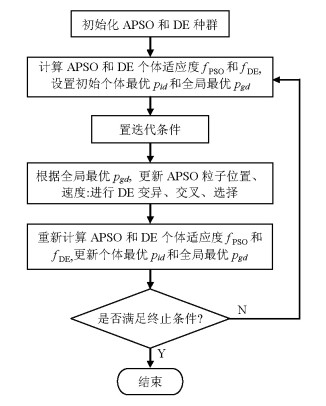
 下载:
下载:
